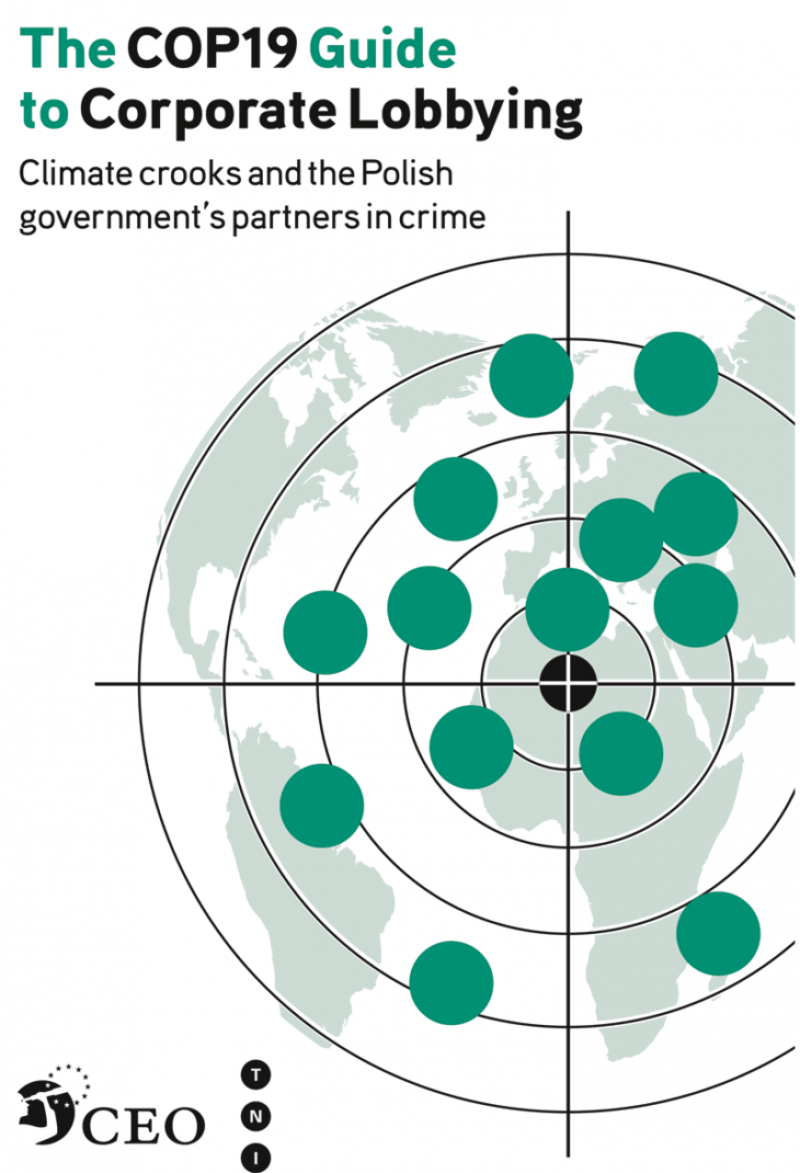
The COP19 Guide to Corporate Lobbying:
New report published by CEO and TNI, a 32-page guide to the web of corporate lobbying and industry capture of COP19, the yearly UN climate negotiations, taking place in Warsaw, 11-22 November 2013. The guide exposes the eleven official corporate partners of the conference, takes a look at some of the other influential Polish lobbies, and examines an extensive list of the lobby groups attending the COP. It also covers the false solutions that are being offered up by these corporate lobbies, such as shale gas, carbon capture and storage (CCS) and carbon markets.
The United Nations Framework Convention on Climate Change (UNFCCC)'s yearly talks have become a "must attend" event for huge numbers of business and industry lobbyists, all eager to promote their preferred "solution" to tackling climate change – solutions which protect their business interests, provide them with new opportunities to profit and most importantly of all, allow them to continue polluting the climate and destroying the environment for everyone.
This year marks the 19th session of the UNFCCC's Conference of the Parties (COP19), and the climate talks are taking place in the Polish capital of Warsaw, 11-22 November 2013. COP19 is the first UN climate talks to have corporate sponsorship, with some of the biggest climate crooks as official 'partners', including ArcelorMittal, Alstom and BMW.
This guide to the web of corporate lobbying and industry capture exposes the eleven official corporate partners of the conference, takes a look at some of the other influential Polish lobbies, and examines an extensive list of the lobby groups attending the COP, according to the sector they represent. These sectors include fossil fuels, cross-sectoral big business groups, carbon market and financial players, agribusiness and agrofuels, as well as some of the big polluting industries. Throughout the lobby guide you'll also find boxes on the false solutions that are being offered up by these corporate lobbies, such as shale gas, carbon capture and storage (CCS) and carbon markets.
###
This story is part of our blog Corporate COP19. Read all the other stories here.
For the latest, follow in Twitter: #CorporateCOP19 @pascoesabido @ecospaceship

Comments
The United Nations published a study in 2006, "Livestock's Long Shadow," documenting that animal agriculture produces more greenhouse gas emissions per year than the entire transportation industry. There are numerous subsequent studies--books, articles, videos, chapters in books, etc.-- elaborating on the UN's conclusions and in some cases going beyond the UN's data. The Worldwatch Institute report of 2009, "Livestock and Climate Change," argues that 51% of the world's annual greenhouse gas emissions--largely methane and nitrous oxide--are from animal agriculture. The authors state,
" Although methane warms the atmosphere much more strongly than does CO2, its half-life in the atmosphere is only about 8 years, versus at least 100 years for CO2.As a result, a significant reduction in livestock raised worldwide would reduce GHGs relatively quickly compared with measures involving renewable energy and energy efficiency."
Yet news reports about the UN Climate Summits never seem to mention either methane or the role of animal farming in climate change or the one thing that could begin to turn around the current juggernaut of climate catastrophes ...adopting a vegan diet. Why? Is there anyone out there at such summits who has ever recommended so much as implementing in every city across the world a "meatless Mondays" campaign?